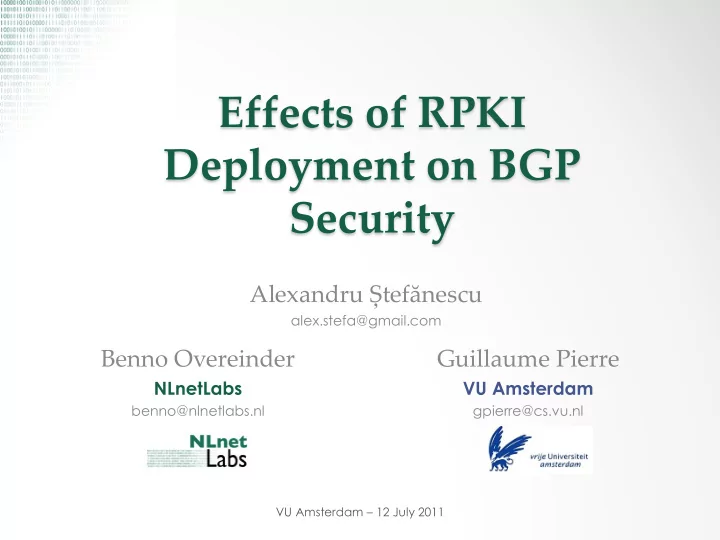

Effects of RPKI Deployment on BGP Security Alexandru Ștefănescu alex.stefa@gmail.com Benno Overeinder Guillaume Pierre NLnetLabs VU Amsterdam benno@nlnetlabs.nl gpierre@cs.vu.nl VU Amsterdam – 12 July 2011
Outline BGP Routing Securing BGP BGP Modeling & Simulation Simulation Results Introduction 2
3
AS Level Internet From http://en.wikipedia.org/wiki/File:Internet_Connectivity_Distribution_%26_Core.svg BGP Routing 4
Border Gateway Protocol (BGP) Responsible for Internet connectivity Concepts Autonomous System (AS) Prefix routing Routing decisions based on Path length Network policies Business relations (customer, provider, peer, sibling) Scaling at massive rate AS count: ~37k Prefix count: ~360k (IPv4) & ~7k (IPv6) BGP Routing 5
Problems with BGP BGP pathological behaviors Large number of types of attack have been described Very few mitigation actions taken Increased impact of attacks on today’s Internet as an essential and ubiquitous service Pakistan Telecom hijacking of YouTube in Feb 2008 15% of global Internet traffic redirected through China Telecom for 18min in April 2010 (acknowledged months later) BGP Routing 6
Securing BGP Main cause of malfunction: misconfiguration Several security additions proposed: S-BGP , psBGP, soBGP, IRV, etc Most important based on RPKI deployment BGP cannot be secured overnight! ASes as commercial entities must also realize it’s in their own interest Securing BGP 7
Project Goals Study the effect of BGP deployment scenarios Find out order to start securing ASes for maximum benefit Better protocol understanding: relation between no. of secured ASs and validated routes Impact of securing just biggest ASs (e.g. Tier 1) How important is securing CDNs? Goals 8
BGP Security Mechanisms Secure Origin Authentication (SOA) Routes in BGP updates contain signature of origin AS Each AS validates signature by looking in a distributed cache Will there be downtimes? Path Validation (PV) When forwarding route advertisements to neighbors, ASes sign route with chain hash function Securing BGP 9
BGP Modeling & Simulation (1) You can’t simulate the Internet! Abstract protocol and network: no physical network modeling, 1 AS = 1 node (ignore IBGP) standard BGP features: explicit prefix tables, announce and withdraw messages, route propagation according to policies, etc. Security model: tag BGP messages as being validated or not security policies assigned to ASes individually BGP Simulation 10
BGP Modeling & Simulation (2) Allow for easy implementation of security solutions We can emulate practically any proposed security additions Do not perform crypto computations, but emulate Abstract what you can, but run everything in (scaled) real-time Gather as much real-world data/scenarios and run the simulation upon them BGP Simulation 11
Our Simulator Enhanced version of simulator by M. Wojciechowski (2009) Java simulator running on DAS-4 homogeneous cluster; low latency network Each AS is a separate thread (>1000 threads per node) Allows easy tweaking of BGP behavior and security policies Uses network annotated adjacencies from CAIDA for 2010 BGP Simulation 12
BGP Topology BGP Simulation 13
BGP Topology BGP Simulation 14
Simulation Process Running scenarios: 1. Assign security policies in various percentages 2. Announce the same prefix from two ASes (one secured AS and one rogue AS) 3. Wait for prefix to propagate 4. Count routes to secured AS Factors: What if topology changes? What is the impact of different types of security policies? What is the impact of different security policy distributions? How does it differ when prefix announced by stubs vs. large ASs? BGP Simulation 15
Security Policies Ignore Standard BGP Prefer Choose validated route between routes of same length Most realistic Secure Always prefer validated routes over unknown Strict Accept only validated routes Uncertain Same as Secure, but introducing introducing route validation unavailability in 10% of cases BGP Simulation 16
SOA: Global Deployment – Random Strategy VS. AS3265 / XS4ALL / #2127 AS30890 / Evolva Intercom SRL / #168 SOA Simulation Results 17
SOA: Global Deployment – Top-down Strategy VS. AS3265 / XS4ALL / #2127 AS30890 / Evolva Intercom SRL / #168 SOA Simulation Results 18
SOA: Global Deployment – Medium Strategy VS. AS3265 / XS4ALL / #2127 AS30890 / Evolva Intercom SRL / #168 SOA Simulation Results 19
Inducing un-connectivity SOA Simulation Results 20
Internet RIRs SOA Simulation Results 21
SOA: RIPE Deployment – Random Strategy VS. AS3265 / XS4ALL / #2127 AS30890 / Evolva Intercom SRL / #168 SOA Simulation Results 22
Securing CDNs The New Internet – “Hyper Giants” CDNs Craig Labovitz (Arbor Networks) SOA Simulation Results 23
SOA: Global Deployment – Random Strategy VS. AS15169/ Google Inc. / #119 AS45773 / PERN AS Islamabad / #10436 SOA Simulation Results 24
PV: Global Deployment – Top-down Strategy VS. AS1357/ Vodafone Espana / #4156 AS35725 / Cosmote RO / #4118 PV Simulation Results 25
Conclusions A bit better understanding of BGP More detailed simulations of security deployment Guide for favorable turnover for investments in BGP security Results show trends instead of specific AS behavior due to many levels of abstractions Future study: Include time dynamic experiments in study (convergence time of validated vs. rogue prefix announcements) Any questions? 26
Recommend
More recommend